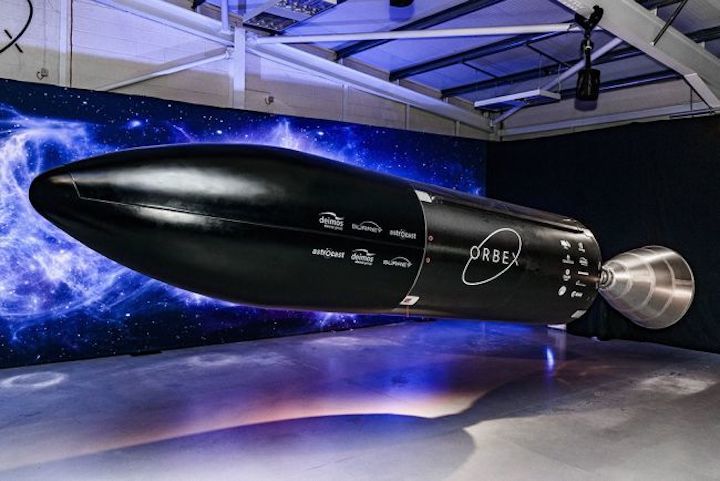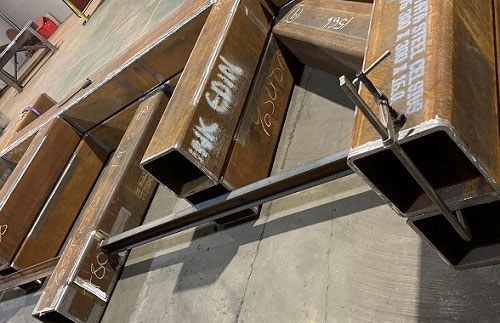Orbex commissions Motive Offshore Group to build state-of-the-art Launch Platform
First orbital launchpad constructed in the UK since Black Arrow was tested over 50 years ago
Launch Platform replicates operations intended at Space Hub Sutherland
20.02.2020
The private space company Orbex recently released the first photos of its rocket factory in Scotland, offering a glimpse at where the commercial orbital rocket called Prime is being built.
Orbex is targeting small-satellite launches from an as-yet-unbuilt spaceport called Space Hub Sutherland. And in early 2020, the company signed up a new client, a company called TriSept, looking to launch a dedicated ride-share mission in 2022.

The Prime rocket will use the world's largest 3D-printed rocket engine, which is powered by biopropane, a clean-burning, renewable fuel source. Using biopropane will reduce carbon emissions by about 90%, compared with standard kerosene-based rocket fuels, according to Orbex.
In addition, Orbex said that it designed Prime rockets to leave no orbital debris; the rockets are also made out of lighter materials, which the company said will facilitate recovering and reusing the main stage. The company plans to launch Prime from northern Scotland as early as 2021.

Founded in 2015, Orbex built its headquarters in Forres, Scotland, where key elements of the launch vehicles are manufactured and tested. From there, the rockets will head to a launch site overseas or the proposed Scottish spaceport.
That spaceport, which will be called the Space Hub Sutherland, is still pending approval for construction. It would be built on the Moine Peninsula in the county of Sutherland, a few miles from Scotland's Atlantic coast. The facility would enable vertical rockets to launch small satellites into low-Earth polar and sun-synchronous orbits.

Orbex engineers inspected the company's newest rocket engine test site in the UK to ensure it will be ready for future propulsion tests. The company also plans to open a second test site in Denmark to allow full-stage static tests.
Orbex personnel will monitor tests at both sites from the company's new mission control center in Forres, Scotland. Here, flight controllers will be able to access data from the launch vehicle during liftoff and flight, providing complete remote command and control. Orbex will use the facility to monitor orbital rocket launches from Scotland and other sites.

Orbex has also installed a carbon-fiber-winding machine at the rocket factory at its headquarters in Scotland. It is one of several new production systems installed at the facility and one of the largest high-speed carbon-fiber winding machines in Europe, according to the statement.
"This 18-meter-long machine automates the rapid weaving of intricate mixes of materials to build the main rocket structures," Orbex officials said in the statement, adding that it has taken several years to create the optimal blend of lightweight carbon-fiber and aluminum composites.
Using this carbon-fiber blend will make the Prime rocket up to 30% lighter than other rockets of its size and allow the rocket to accelerate from 0 to 830 mph (1,330 km/h) in just 60 seconds, Orbex said.

Orbex's carbon-fiber winding machine provides automated control of the fiber strands, also known as rovings, and allows Orbex to weave different materials together to build the main rocket structures.
"Numerous characteristics, from the basic material properties to the angle of the stands, all combine to ensure essential structures can tolerate large pressures — in some cases up to 500 times atmospheric pressure — as well as the intense dynamic loads of an orbital space launch vehicle," according to the statement from Orbex.

This photo shows a bobbin from which the fiber strands are woven. The blend of materials used in the carbon fiber for the construction of the Prime rocket was developed by Orbex over the last several years, according to the statement.
"This equipment allows engineers to have complete control over the design and pace of manufacture of all carbon fiber tanks, including the main stage tanks, which can be wound in a matter of hours," according to the statement from Orbex.

Engineers trim the carbon-fiber fabric before placing it in a component mold for the heating and curing process. The carbon fiber is pre-impregnated with a resin system to reinforce the fiber blend. This fabric is not only lighter than traditional aerospace materials, but also nearly twice as strong, according to Orbex.
Orbex has received funding from the UK Space Agency's Spaceflight Program to support the manufacture of this carbon-fiber technique. Orbex has also received support from the European Horizon 2020 SME Instrument program, which is part of the European Innovation Council and provides funding opportunities to small companies like Orbex.

In this photo, Orbex engineers are drilling the carbon-fiber composites, which are widely used in specialized, high-performance products like aircraft, race cars and spacecraft.
"We're creating rockets in a way that hasn't been done before," Chris Larmour, Orbex CEO, said in the statement. "The whole point of NewSpace — private enterprise getting involved in spaceflight — is to provide faster, better and cheaper access to space. Burning through hundreds of millions of dollars on robotic assembly lines or hundreds of staff to produce heavy, metal rockets is an antiquated approach."

At the same rocket factory, Orbex also recently installed a full-scale autoclave, which engineers use to "cure," or harden, the carbon-fiber structures under heat and pressure. The autoclave uses high temperatures and up to seven times the atmospheric pressure to bind the materials and strengthen the carbon fiber.
In this photo, an Orbex engineer verifies the temperature inside the autoclave to ensure a solid bond is established between the carbon fiber composites. The autoclave is used to cure all composite rocket parts, including the main-stage tanks.
"In just a few hours, these machines can process large composite rocket parts to create a strong and reliable structure that is ready for the extremes of space," according to the statement.

This photo offers an up-close view of a 3D-printed rocket engine. 3D-printing incorporates tiny design details and features that would otherwise require additional processing time. Using this technique, Orbex is able to create a complete rocket engine in just five days.
In addition, Orbex believes its 3D-printed rocket engine may be safer than conventional engines, as it is manufactured as a single piece without joints, seams or welds. That should make it better able to withstand extreme temperature and pressure fluctuations of spaceflight, according to Orbex.

Each Prime rocket requires six 3D-printed engines on the first stage and a seventh engine on the second stage. Weighing just 16.5 lbs. (7.5 kilograms), each of Orbex's 3D-printed rocket engines can lift 7,000 lbs. (3,200 kg) and requires only 8,800 lbs. (4,000 kg) of fuel per launch. Each Prime rocket is approximately 50 times more fuel-efficient than other small-satellite launch vehicles, which use up to 440,000 lbs. (200,000 kg) of fossil fuels.
In addition, Orbex has been testing the performance and reliability of biopropane-fueled engines, which use "clean" fuel supplies to reduce carbon emissions, compared with conventional hydrocarbon fuel-fired rockets, according to a statement.

High-performance turbo-pumps that spin at up to 25,000 rotations per minute feed fuel into the rocket engines. This photo shows the gearbox, which is part of a system that provides high-speed testing and rotor balancing of rocket engines, according to Orbex.

Orbex has also developed a full hardware system the company calls a "flat sat," which consists of flight computer and guidance sensors.
"Many satellites are now as small as a smartphone," Larmour said in the Orbex statement. "Our goal is to service this new market by making smaller, more efficient launch vehicles with a tiny [carbon dioxide] footprint and zero orbital debris."
He is also targeting scheduling to keep the reusable launch vehicles flying regularly. "We can only do that [by] re-thinking how we do it, rather than copying the past."
Quelle: SC
----
Update: 10.12.2021
.

Orbex commissions Motive Offshore Group to build state-of-the-art Launch Platform
First orbital launchpad constructed in the UK since Black Arrow was tested over 50 years ago
Launch Platform replicates operations intended at Space Hub Sutherland
Forres, UK, December 9, 2021 – Orbex, Europe’s leading private small satellite launch services provider, has today announced it has started construction of its first state-of-the-art Launch Platform, the first orbital space launchpad to be built in the UK for more than half a century.
Orbex has commissioned Motive Offshore Group, a leading Scottish company specialising in the design and manufacture of marine and lifting equipment, to fabricate and install the Launch Platform at a dedicated test site near Kinloss, close to the Orbex headquarters in Forres, Scotland.
The Launch Platform, known as Orbex LP1, is expected to be fully operational by early 2022. An artist’s visualisation of the new facility has been released by Orbex today, as well as images of the ongoing construction at Motive Offshore.
The new Launch Platform will support the testing of Orbex´s Prime rocket, a micro-launcher designed to transport small satellites weighing around 150kg to low Earth orbit. Although actual launches of the Orbex Prime rocket will not take place at the Kinloss site, the Launch Platform will be fully capable of launching an orbital rocket, allowing for full ‘dress rehearsals’ of launch procedures.
Orbex LP1 is the first launchpad of its kind to be built in the UK since the High Down Rocket Test Site facility on the Isle of Wight, which was decommissioned in the early 1970s[i]. High Down was the test site for the Black Arrow rocket, the first – and so far only – British-made rocket to successfully deliver a satellite into Earth's orbit, launching from Woomera in Australia on 28 October 1971[ii].
The new Launch Platform in Kinloss will enable Orbex to accelerate plans to launch Prime from its ‘home’ spaceport at Sutherland in the North of Scotland. Space Hub Sutherland is the world’s first carbon neutral spaceport and the only spaceport in the UK to have received full planning permission. Construction of the spaceport is due to begin early in 2022 ahead of the first expected launch of Orbex Prime later in the year.
Motive Offshore Group has a rich heritage in the design and manufacture of bespoke deck and subsea equipment, and is a major supplier across the energy, oil and gas industries. All equipment is manufactured onsite at Motive’s headquarters in Banff, Scotland, and is built and tested to meet strict international standards across highly regulated industry sectors.
The new Launch Platform will be comprised of all the infrastructure and supporting services that will enable a wide variety of integration tests to take place during launch campaign preparation, including the testing of the main propellant tanks and multi-engine hot fire testing under vertical firing conditions. It will also enable the launch operations team to test launch procedures including rollout, strongback erection and fuelling procedures in advance of the first expected launch.

Chris Larmour, CEO of Orbex:
“The ability for our engineers to test Prime on its own launchpad is a major advancement on the roadmap to launch, and we are happy to already be constructing this major piece of infrastructure with Motive Offshore, a partner which has a very strong track record in other relevant industries. This will be the first launchpad of its kind built in the UK for more than half a century and we look forward to seeing it completed and ready to go into service in the New Year.”
James Gregg, COO at Motive Offshore Group:
“Motive Offshore Group welcomes the opportunity to work with Orbex on this exciting project. Whilst the Aerospace arena may be new territory for Motive, we are completely focused on the standards and performance required to deliver outstanding custom engineering, so very much look forward to transferring our skills and expertise on this project.”
About Orbex
Orbex is a UK-based spaceflight company with headquarters, production and testing facilities in Scotland, and design and testing facilities in Denmark. Orbex staff members have professional backgrounds with NASA, ESA, Ariane and several commercial spaceflight organisations. The company is now funded by two of the UK’s largest and most active venture capital funds, BGF and Octopus Ventures, who join two of Europe's largest venture capital funds, Heartcore Capital and the High-Tech Gründerfonds, as well as strategic investor Elecnor, parent company of Deimos Space, the UK Space Agency (UKSA), the European Space Agency (ESA) and the European Commission Horizon 2020 programme.

Quelle: ORBEX